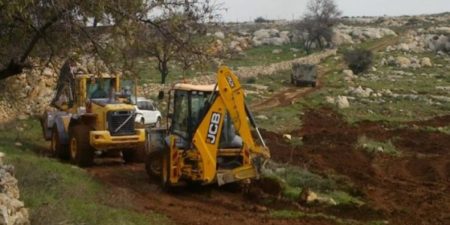Madeeha Araj/PNN
The National Bureau for Defending Land and Resisting Settlements stated, in its latest weekly report , that the far-right Israeli Defense Minister, Naftali Bennett announced, last week, the approval of seven nature reserves in the West Bank, with an area of 130,000-State dunams — 20,000 of which ones belong to Palestinian citizens. Bennett’s announcement also included approval for expansion of 12 already existing and approved by the Civil Administration in 2008.
The announcement included Wadi Al-Malha Reserve, 14,236 dunams; Wadi Tireza Reserve, 200 dunams; and Wadi Ogh Reserve, 5,700 dunams — all private Palestinian lands.
Bennett claimed that his ministry continues to develop the Jewish settlement in Area C “with actions, but not with words,” adding that, in Judea and Samaria, there are picturesque natural sites to be expanded and new ones be established, soon. In his announcement, Bennett also called on Civil Administration to transfer the new nature reserves’ responsibility to the Nature and Gardens’ Authority, so that it can be opened before the public. Bennett’s announcement mentioned a large number of sites, including the Surek Cave, also known as the High Halimat Cave or the Candles Cave, near Beit Sorek; Wadi al-Muqlaq, on the eastern slopes of the Mount of Olives, in Jerusalem; Wadi-Malha, to the southern Jordan River; and Wadi Al-Far’a, the gateway to the northern Jordan Valley.
Moreover, Bennett also announced the expansion of 12 existing natural reserves, namely the mountain peaks located west of the Dead Sea; Fsayil & Um Zoka, in the Jordan Valley; Ein al-Fashkhah, adjacent to the Dead Sea; Kharouba village, east of Ramla and inside the West Bank; Wadi Silvadora, north of the Dead Sea; Ghadir Mountain, east of Tubas; Eioun Kana, north of the Dead Sea; Wadi Al-Malha, in the middle of the Jordan Valley; and Qumran, in the Jericho area — which means placing a hand on large areas of Palestinian land classified as Area C. According to B’Tselem’s data, Israel announced that about 20% of the Jordan Valley has become “natural reserves, and national parks.”
In general, there are 700 km2 in the West Bank that have been declared natural reserves, in addition to 78 km2 as forests, so that the percentage of those lands reaches 13.7% of the total area of the West Bank. This is to say 59 nature reserves, most of which are located in Area C, according to the Oslo Agreement, but under Israeli control, which is subject to use for the benefit of settlements in the northern Jordan Valley — areas that Israeli Prime Minister Benjamin Netanyahu is promoting for his plan to impose Israeli sovereignty, there, if he wins the elections — the nature reserves in Wadi Qana, Salfit, and others in the Bethlehem and Hebron governorates. With this in mind, the matter is clearly not limited to nature reserves, but also includes military bases or state lands.
Within the context of settlement projects, Israeli occupation authorities issued military orders to seize 350 dunams of agricultural land from Al-Khader and Artas villages, to the south of Bethlehem and specifically in the Bakush, Dhahr Ein, Hammad, Al-Shagv, Zakandah, Ein Al-Qasis, Shushahla, and Rajm areas, with the aim of expanding the bypass settlement road n. 60. This means razing and rubbering more land, as well as adding 150-meter recoil, preventing farmers from accessing their lands.
Israeli authorities seized 127 dunams of land in Burqin and Kafr al-Dik, to the west of Salfit, under the pretext of it being state property. Israeli forces began implementing the second stage of establishing a new water line on the lands of the Qalqila Governorate, which extends from the 1948 line to Nablus, for the purpose of watering settlements. This seven-kilometer project was announced in 2018, and entails the destruction of more than 1,000 olive trees and the confiscation of one hundred dunams of lands.
In Nablus, groups of settlers gathered on a number of roads, especially the Hawara and Yitzhar roads, and in the Orif lands, disrupting study at Orif Secondary School. At the same time, settlers attacked residential houses with stones, in the Madama village, and tried to climb their roofs, but people from around the villages came to help.
In Salfit, occupation authorities announced, earlier, the expansion of the Bruakhin settlement by adding hundreds of new settlement units. This prompted the settlers, there, to bulldoze 127 dunams in the Thahr Subh area, on the northern side of Hajah town, classified as a state land located in Areas B & C, although its owners possess documents which prove their ownership.
(edited for the IMEMC by c h r i s @ i m e m c . o r g)

